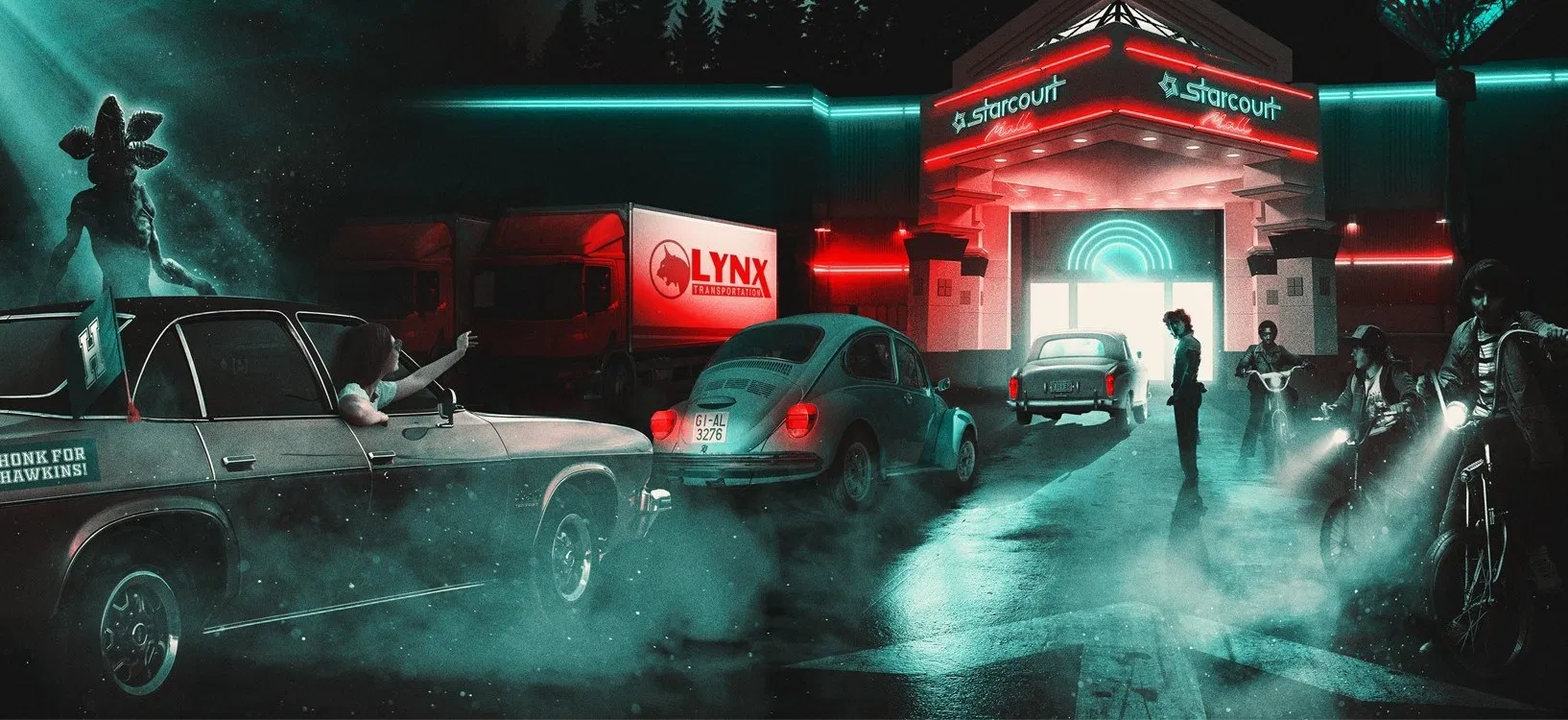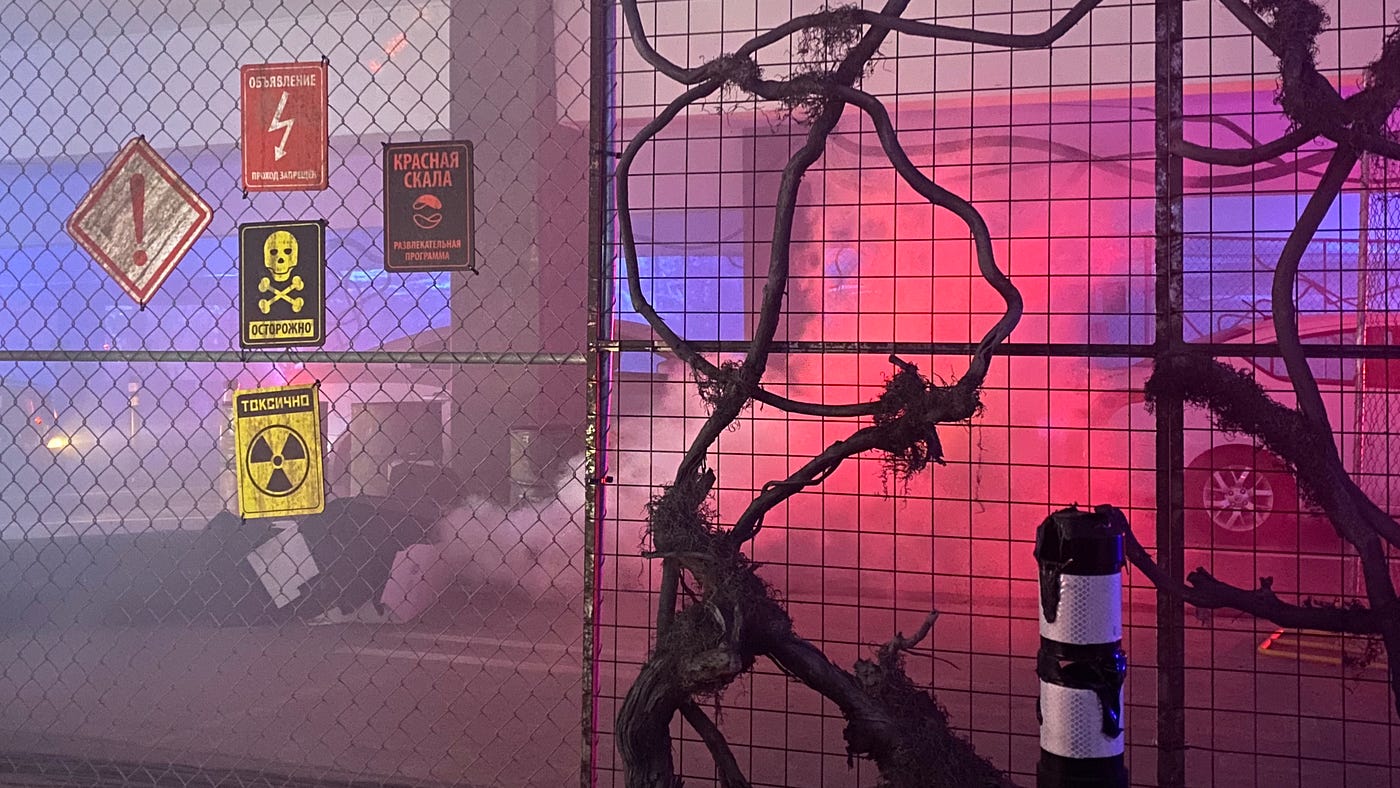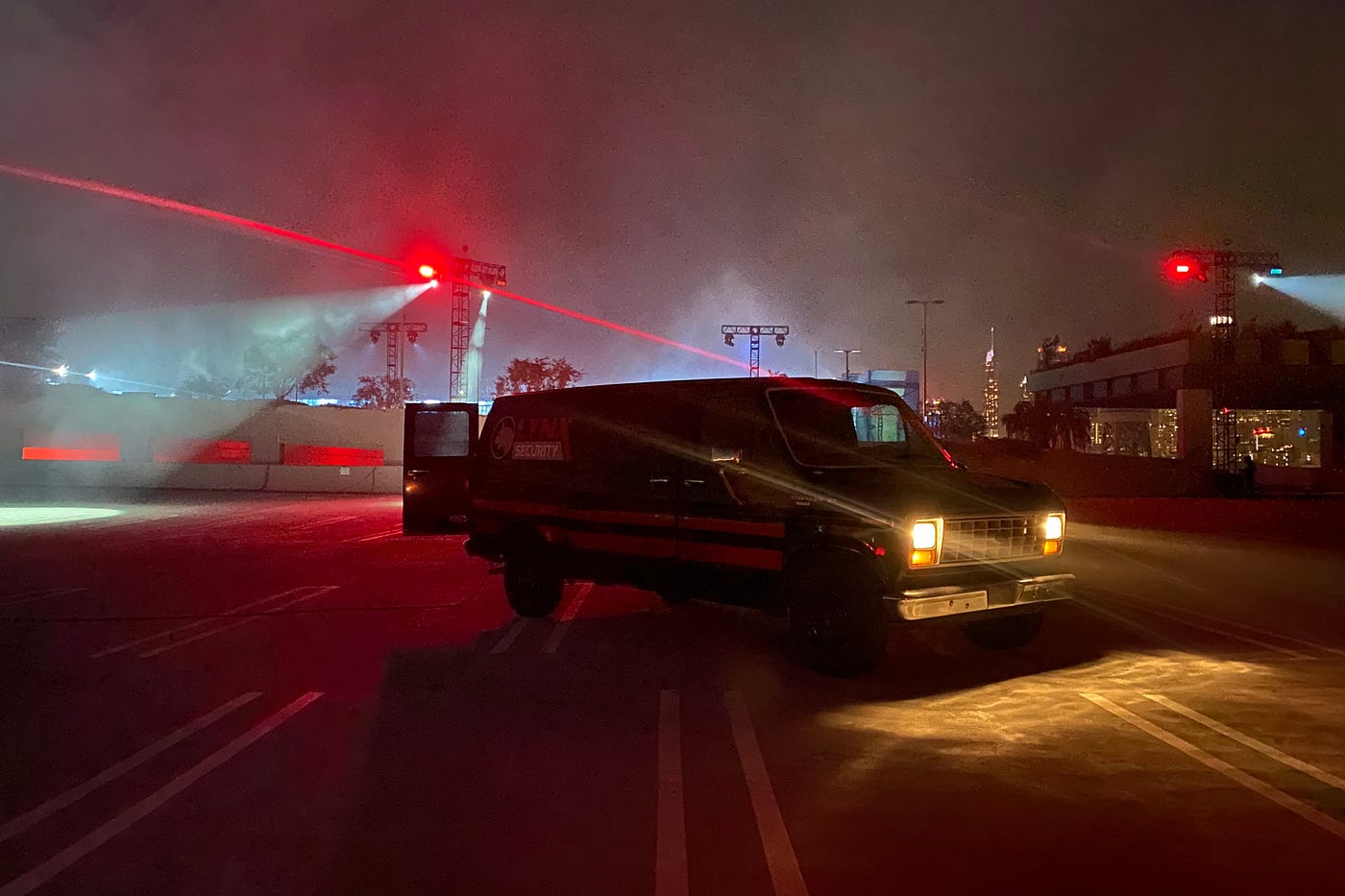‘Stranger Things: The Drive-Into Experience’ Drives It Home (Review)
I’m at the combination parking-lot-and-Upside-Down!


Several weeks ago, I went to a high school reunion. Reunions are a time machine to adolescent emotions, now laminated to the realities of adulthood. The byproduct of which is often a mix of nostalgia, deep affection, and regret, with a visceral remembrance of limitlessness — the open promise and full possibilities of life yet to come. On the drive over, I was excited but unsure how the event would play out. What would the evening be like? Would I recognize anyone? Would it be fun?
Queuing up to the ROW DTLA’s parking lot, my date and I tuned our radio to 90.5 FM as a Hawkins High cheerleader high-kicked an enthusiastic welcome, her poms undulating like metallic sea anemones. This “reunion” was like no other. We were transported from Los Angeles in 2020 to Hawkins, Indiana in 1985 and into the world of Stranger Things: The Drive-Into Experience, presented by Netflix and Fever, with Secret Cinema. As a well-versed fan of the TV show, I was eager to explore the world of Stranger Things through an immersive drive-into event, especially since I’d not yet experienced a Secret Cinema production in person.
(Major spoilers follow.)

Due to the area’s recent “chemical leak,” the Hawkins Police Department advised everyone to remain in their vehicles. This succinct, effective detail was served up via in-world emails; by assimilating pandemic conditions, with a rationale that aligned with the series’ narrative, it felt almost natural to be confined to our cars once we arrived, surrounded by our masked outdoor hosts.
Cruising by Stranger Things antagonist Billy Hargrove’s Camaro (veiled in smoke from a fog machine and backlit by the neon glow of a “Scoops Ahoy” sign), we pulled up to the outdoor facade of “Starcourt Mall,” a raised stage, flanked in neon and with a large screen on its back wall. Ushered into lanes by a mix of traffic guides and concession carhops (throughout the Drive-Into, parking attendants fulfilled both functional duties and atmospheric roles), we began our journey bathed in an ocean of synth from classic ’80s songs such as “Enola Gay,” “Tainted Love,” “Mickey,” and the graveled crooning of Huey Lewis’ “The Power of Love.”
An actor portraying Mr. Scott Clarke, everyone’s favorite science teacher and head of the Hawkins A.V. Club, deejayed the reunion from center stage while filmed from below by two women kitted out with feathered hair and neon spandex (so much neon!). The video feed, courtesy of a monstrous VHS camcorder, was broadcast on the rear screen. Mr. Clarke and his mustache led us through activities, the most comical being “Glove Box Bingo,” during which we excavated the contents of our car’s “junk drawer.”

Actors embodying Stranger Things characters crisscrossed the lot, reenacting brief scenes from the show on their brick-sized walkie-talkies (transmitted over our car’s radio). An actress subbing in as the character Max skimmed between cars on a skateboard. Casting, costuming, and performances were top-notch; the whole aesthetic — clothing, hair, physical attributes, vocal quality, and mannerisms — of performers so closely resembled that of the television series’ cast, it elevated the entire experience.
Get Laura Hess’s stories in your inbox
Join Medium for free to get updates from this writer.
SubscribeSubscribe
Next, we funneled into the parking garage and spiraled up the ramp until we landed on a level… in Russian. Among Cyrillic signage and precise rows of hazy spotlights, parking attendants in fatigues directed us into two long rows, our vehicles side-by-side with our headlights facing the other row of cars, all with an asphalt runway in between. The production’s spotlights lit this center section, which became the performers’ stage. At the aisle’s end, a concave cone embedded into the concrete wall pitched light beams down the row. This was the Key; in the TV series, Soviet scientists constructed the Key to reopen the Gate into the Upside Down (the terrible alternate dimension controlled by Stranger Things’ ultimate adversary: the Mind Flayer). Rebuked by a Soviet officer while sneaking photos of the Key, we cowered, laughed, and yelped in our car as performers portraying Steve, Robin, and Dustin ran amok, goading us, taunting the officers, and fleeing from the impressively costumed Demogorgon.

The design team for this experience made expert use of the environment and staging. Leveraging human performance, lighting effects, and the garage’s inherent structure, the space felt like an underground, top-secret military base. And, since the double row of cars spanned the length of the garage aisle, the cast and the Key were likewise doubled: a Key at each end of the aisle and two seemingly identical actors each for Robin, Steve, and Dustin. Not only did this maximize performer visibility and engagement for all vehicle occupants, it was knitted into the production’s plot. The two Robins came together through the Key’s narrative from the TV show: once the device was deployed and opened a rift (known as the Gate) into the Upside Down, it created “spatial distortion” and produced a mirror effect, pantomimed in sync by the actresses at the aisle’s center, before they returned to their respective performance fields.
With the Gate opened, we moved up a level in the garage — and into the Upside Down itself. Dark and foggy, the Upside Down coughed snow-like debris as we snaked through it. In this domain, parking attendants were sheathed in yellow hazmat suits, peering at us through our window glass with flashlights. Cars crept into compact, serpentine formations, hemmed in by radioactive waste barrels and wire barriers covered in vines. Screens spliced the space and projected a video montage from all three of the show’s seasons.
A more passive segment, this level generated debate between me and my partner. Although I appreciated his frustrations with the lessened interactivity, I found it delightful to be engulfed in the Upside Down while watching a unique mashup of the show’s footage. Thus far, the production had recreated Stranger Things’ lore and characters. Fusing actual content from the show felt grounding and additive. And, it reinforced the incredible casting for the Drive-Into experience.
From there, we traveled up to the roof deck — and to the denouement. Again, the design team incorporated the garage’s attributes and cast duplication. Against a surreal backdrop of massive screens running footage from the series, multiple performers for each character were spread out across the set, with a few performers even levitating above it. These performers didn’t pantomime identical choreography or reenact tantamount scenes from the show. Instead, contrasting vignettes from all three seasons were incorporated. For example, five pairings of Eleven and Hopper silently mimicked excerpts (such as dancing, cleaning, and arguing), which modeled the arc of their relationship. It was a nuanced way to integrate touchpoints from the entire series, while ensuring visibility for the total audience.
After snailing through The Elf on a Shelf’s Magical Holiday Journey, I was reminded that processional drive-thru experiences often constrain performer-audience exchanges. The Stranger Things Drive-Into team designed a compelling, four-part, immersive theatre production with its audience encased in vehicles. This was no small feat given that the three garage segments required synchronistic timing (and possibly the lot section, too), so that all groups migrated to the next chapter concurrently or in quick succession.

By crafting a cohesive experience of independent segments, during which I parked my car, I felt as if I were gifted time: time to absorb and examine the surroundings, and to develop relationships with the performers. Although brief, these interactive moments stretched my imagination and suspension of disbelief outside of my car. I didn’t feel trapped in an automobile-snowglobe while performers repeated choreography devoid of input from the audience; I felt like I became part of the show and was invested in it as a result. Through story construction and set design, our cars became a way to explore worlds and facilitate transitions, rather than operating as an isolating capsule separating us from the experience.
The creators of Stranger Things: The Drive-Into Experience converted the monotony and banality of a parking garage into a multifaceted world without extraneous props or superfluous set pieces. This was still a monumental production — there’s nothing meek about it — but it worked because its production design was rooted in the Stranger Things narrative and strategic in its vision. By marrying an existing environment to the show’s lore, the experience ferried me inside Stranger Things. It felt authentic, real, and magical — and also left me full of nostalgia, deep affection, and imagining the possibilities yet to come…. Truly, a reunion like no other.
Stranger Things: The Drive Into continues in downtown Los Angeles through March 7, 2021. Tickets are $89 and up.
Discover the latest immersive events, festivals, workshops, and more at our new site EVERYTHING IMMERSIVE, new home of NoPro’s show listings.
NoPro is a labor of love made possible by our generous Patreon backers. Join them today!
In addition to the No Proscenium web site, our podcast, and our newsletters, you can find NoPro on Twitter, Facebook, YouTube, Instagram, in the Facebook community Everything Immersive, and on our Slack forum.
Office facilities provided by Thymele Arts, in Los Angeles, CA.